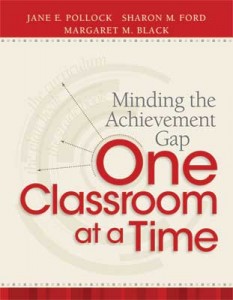ESL Instruction That Works
Minding the Achievement Gap One Classroom at a Time
by Jane E. Pollock, Sharon M. Ford, and Margaret M. Black
(ASCD, 2012 – Learn more)
It took the authors a page to explain the title of this book to me. As I read their explanation for the title, it made me think about a joke that isn’t understood: if you have to explain it, it might not be a very good joke.
I think the title is an unfortunate book choice because it doesn’t make a connection to previous books in this unofficial series, going back to Marzano’s Classroom Instruction that Works (2001). I would have picked up this book faster if the title were “Implementing Classroom Instruction that Works with ESL and EC Learners.” But regardless of the title, it’s a book well worth reading.
The gap between research and practice

As a refresher – The nine strategies are: identify similarities and inferences, summarize and take notes, recognize effort and provide recognition, provide homework and practice, use nonlinguistic representations, use cooperative learning, set objectives and provide feedback, generate and test hypotheses, and use questions, cues and advance organizers.
As an ESL teacher, five years after Classroom Instruction that Works was published, I eagerly purchased Classroom Instruction that Works with English Language Learners. Great book. But, even referring numerous times to both books, I still didn’t have a reliable strategy for incorporating the nine high-yield research based strategies on a regular basis in my classroom.
But now I do.
GANAG Lesson Planning
The GANAG Lesson Planning Template, which incorporates the nine strategies, was first brought to educators’ attention in Jane Pollock’s 2007 book, Improving Student Learning One Teacher at a Time. I missed reading that book. Fortunately, that lesson plan format is not only repeated in this current book for classroom teachers, but the format is redesigned (GANAG Plus) to better meet the needs of specialists who work with English Language Learners (ELLs) and Exceptional Education (EC) students.
An update of Madeline C. Hunter’s Mastery Teaching schema published in the 1970s, the GANAG schema guides teachers to intentionally incorporate the nine strategies into daily classroom learning activities. — from the Introduction
At this point, you might wonder about the continuing relevance of nine strategies that are based on research prior to 2001. The authors note that while the strategies still hold up in practice, they have “updated the discussion here to incorporate more recently published research on the power of teacher clarity and teacher-student relationships.” (p. 56)
The GANAG Lesson Planning Template was created not only as a way for teachers to apply research-based, high-yield strategies within our classrooms, but as learning strategies that can be taught to our students. GANAG is an acronym for its five steps.
G = Share the goal/standard(s) and objective(s)
A = Access prior student knowledge
N = Acquire and process NEW INFORMATION
A = Apply knowledge in a new situation and create original ideas
G = Goal Review or summarize
(You’ll see some further explanation at this school district webpage.)
Alignment with SIOP
As an ESL teacher, I especially liked seeing the GANAG schema aligned with Sheltered Instruction Observation Protocol (SIOP). I’ve been playing around with various SIOP lesson plan formats for several years. This year, I’ll use GANAG to not only incorporate the nine research based practices but to also blend in features of SIOP. The language goal can easily be placed next to the content goal. (I do wish the various templates and samples shown in the book were available online.)
So what other changes will I make this year based on this book? Instead of journals in my classroom, this year I’ll be using high-yield interactive notebooks (IN). While not a new concept, the notebooks described in this book (IN9s) are set up in a specific format to maximize students’ involvement in their learning and to deliberately use the nine researched based strategies.
The authors clearly describe setting up classroom IN9s as well as recommend and provide samples of various grade level IN9s. They also recommend elementary teachers consider using “foldables” to place in their notebooks. For anyone not familiar with Dinah Zike’s work with foldables, visit her site at http://www.dinah.com.
As a teacher who co-teaches with content area teachers, I found the authors’ discussions and examples of various co-teaching models to be useful not only for EC specialists, but for ESL teachers and all co-teaching specialists and their content area partners.
The achievement gap
Early in the book the authors review the history of the achievement gap in the United States and conclude that closing the achievement gap is not a recent effort but an ongoing challenge. They correctly acknowledge that teachers are the most important factor in student success and educator’s voices are heard regularly in this book between chapters.
The book concludes that teachers need to deliberately use research-based teaching practices to improve student performance. In this book, they have provided us with a lesson plan format for intentional and successful teaching and learning, a way to increase student engagement with interactive notebooks (IN9s), and chapters that address academically at-risk students.
One classroom at a time is the only way as a nation we can really address the reality of our ongoing achievement gap. Reading this book is a good first step for both “minding” and closing the achievement gap in your own classroom.
Julie Dermody, NBCT, is currently an ESL teacher in the Chapel Hill-Carrboro (NC) City Schools. She has also served as an elementary, middle and high school teacher, a reading specialist and a teacher of gifted students. Her article about ESL students, “Going for the Growth,” appeared in the September 2012 Educational Leadership (online edition).






































I have been searching for a way to blend SIOP and GANAG – apparently you’ve found a way. Is this the book, “Minding the Achievement Gap: One Classroom at a time” that the templates to couple GANAG and SIOP into one lesson plan?